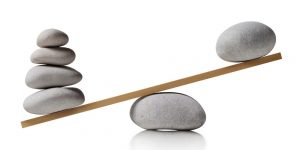 It’s been a year to remember for the stock market. And it’s only mid-February. The Dow Industrials have been up or down more than one percent in 20 of the first 30 trading days of the year. As we discussed last week (Is It Time To Sell?), the market’s volatility has many investors wondering what, if anything, to do. How do you know when it is time to buy? Is it now? Here are five reasons:
It’s been a year to remember for the stock market. And it’s only mid-February. The Dow Industrials have been up or down more than one percent in 20 of the first 30 trading days of the year. As we discussed last week (Is It Time To Sell?), the market’s volatility has many investors wondering what, if anything, to do. How do you know when it is time to buy? Is it now? Here are five reasons:
Buy to build 
It’s always a good opportunity to invest. Investing is a long-term pursuit, not to be mistaken for its polar opposite, speculation. Wealth is created by earning, spending less than you earn, and investing for decades. Outside of a reserve for emergencies and known short-term needs, your money should be invested in risk assets that have the potential to grow for years, decades and generations. The long-term historical direction of securities markets is unequivocally up, but you have to be in to board the ride. We can help you get there.
Buy to get more
With perfect hindsight it is evident your investment dollars will buy more now than they would have a month ago, a year ago, and even longer ago. Some markets are down to 2006 prices (emerging markets) and some are down even farther (oil). The Dow is down 7 percent since you made your New Year’s toast. If you had an easy 7, 20 or 40 percent discount on groceries, broadband or clothing, you’d probably consider it a good thing. The same reaction makes sense for securities (although few individual investors take advantage of it).
Buy to diversify
There’s more than one market, many more. A diversified portfolio includes stocks, bonds, and alternative investments. Domestic and international location matters a great deal due to currency influence and risk management. In other words, your manager has at least six different markets to coordinate for you. When someone says ‘markets are down’ (stocks in 2016 for example) your first reaction should be ‘and which ones are up’? (gold, big time). If you find that your portfolio is tilted profoundly to just one or two markets, you’re taking more risk than you need to. Give yourself a sturdier foundation by adding more asset classes. It’s always a good time to diversify.
Buy to be timeless
What if February 2016 is 2008-09 all over again? See our June 2013 article about the 2008-09 Great Asset Rearrangement. Market Timeless, Not Market Timing shows an excellent way to navigate a simultaneous global meltdown and mashup. The synopsis is this: because you can’t know when prices will go up or down, buy a little each month over a year or two. You’ll end up with an average price that’s in the middle, so you won’t find yourself in a position to have to guess when the time is right.
Buy to rebalance
If you or your advisor is making investment decisions based on headlines, expect trouble. The predictive value of news is scant. On the other hand, your portfolio sends you messages every day, if you know how to hear them. For instance, in volatile markets, your asset allocation can get way out of line. Buying more of weaker performers helps to right the ship. Remember, there’s a big difference between managing and monitoring. Managing is better. Max and I have a managing checklist we go over every day, pushed to us via our triggers, monitors and criteria. It keeps us “always on” for you.
This is not the time to buy on a hunch or a “sure thing” tip, but it’s an ideal time to get your portfolio in order for whatever lies ahead. Special rules for all types of situations apply. I would restate ‘buy’ however, as ‘fortify’, ‘rearrange’, ‘control’, and ‘audit’, some of our favorite Osbon Capital portfolio words.
John Osbon – josbon@osboncapital.com
Weekly Articles by Osbon Capital Management:
"*" indicates required fields
